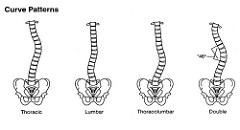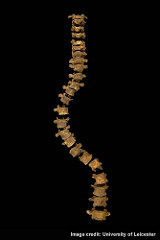Is Scoliosis Linked to Abnormal Spinal Fluid Flow?
Today we have the great pleasure of having a guest blogger, someone you may have heard of in a few of our other posts, Dr. Grant Tully (the human chiropractor). Dr. Tully practices out of Rochester Hills, Michigan and is our go-to guy when it comes to all things chiropractic. Though we handle the fur babies of the world, Dr. Tully takes care of their humans, and we are always ecstatic when he takes the time to write us a guest blog. Recently he found an article linking abnormal Cerebrospinal Fluid flow (from structural shifts in the spine) to SCOLIOSIS (a severe abnormal structural shift that can compress the organs due to its incorrect curvature). The reason we find this so fascinating is because the study was done on fish! We love it when there’s research out there supporting what we do and also showing the effects of what a severe structural shift can do to the body. Take a moment to read his blog below or click right through to his website and explore more!
Is Scoliosis Linked To Abnormal Spinal Fluid Flow?
 According to researchers in a recent article, the answer to the title’s question is yes. Does this mean it is the only mechanism in play with respect to developing a scoliosis? My opinion is no. There are other contributing factors but this is a good start on a topic that has confused the medical world for decades.
According to researchers in a recent article, the answer to the title’s question is yes. Does this mean it is the only mechanism in play with respect to developing a scoliosis? My opinion is no. There are other contributing factors but this is a good start on a topic that has confused the medical world for decades.
Your central nervous system (which includes your brain and spinal cord) is incredibly complex. It is the most complicated computer on the planet and is constantly controlling millions of items simultaneously. It is bathed in cerebrospinal fluid (referred to as spinal fluid as well). This fluid brings nutrition, removes waste, and helps cushion your brain against trauma. Research on spinal fluid flow and its importance is starting to pour into journals. Not only is it linked to scoliosis, but it may have a role in neurodegenerative disorders and much more. Why am I interested in this as a structural chiropractor? Structural shifts of your spine away from normal can alter spinal fluid flow.
The first question that needs to be answered is, what is a scoliosis? It is a three dimensional shift of your spine away from normal spinal alignment. You may remember having a simple screening test done as a kid while you were at school. The reason for this is because a scoliosis tends to develop during the adolescent growth period. Some of the causes of a scoliosis are physical defects of bone and muscle. However, a larger percentage are diagnosed as an adolescent idiopathic scoliosis. This is a fancy way doctors say they have no idea what caused the condition. Fortunately, this new research may shed light on that.
What are the consequences of a scoliosis?
1) Pain – When the spine is in normal alignment it shares the stress placed on it by gravity evenly among the necessary structures. When the spine is disfigured, the stress becomes pathological and muscles, joints, and the nerves conducting pain are put under tension. This tension contributes to the pain someone with a scoliosis may experience.

2) Abnormal Development – There is a principle known as the Hueter-Volkmann Law. This law states that the growth plate will develop bone unevenly if there are different stresses placed upon it. The side where there is “compression” will grow slower than the side where there is “traction” of the bone. This can lead to uneven skeletal growth.
3) Altered Nervous System Function – As the spine shifts away from normal, neurologic degenerative strain is passed to the spinal cord and nerves (the electrical wiring of your body) via denticulate ligaments. This strain can alter the nerves in a way similar to a clipped wire in your house. The conduction will be altered between the brain and muscles, organs, skin and everything else the Central Nervous System controls.
There are many more consequences beyond the ones listed above. Your spine is the foundation of your body, and when the foundation is off, problems can arise everywhere.
How do structural shifts of your spine alter spinal fluid flow? When your spine shifts away from normal, it transmits stress via denticulate ligaments to the spinal cord and nerves as I mentioned previously. Some of this stress can traction your brain stem, which unfortunately may pull part of your cerebellum down as well (Book reference 1 below). The brain can block the foramen magnum of your skull which will impede the spinal fluid flow leaving your brain. This can cause a backup of spinal fluid and is frequently seen in a condition known as hydrocephalus.
In addition, when you are standing, the spinal fluid in your brain drains through the spinal venous plexus rather than the internal jugular vein. These veins do not contain valves and are dependent on hydrostatic pressure. When the pressure builds up below the brain, secondary to structural shifts of your spine, the fluid cannot flow the direction it needs to exit. This can lead to faulty spinal fluid hydrodynamics.
As you can see, altered spinal fluid flow may be implicated in a number of conditions. It is becoming apparent that we need normal flow to function optimally. We must now figure out what alters it. Abnormal spinal alignment appears to be one contributing factor among a potential group. The importance of spinal alignment is become more evident daily. When was the last time your spine was checked?
References:
1) https://www.karger.com/Article/Abstract/365467
Photo Credits:
Spinal Curve Patterns via photopin (license)
The complete spine via photopin (license)
Dr. Tully owns Precision Chiropractic in Rochester Hills, Michigan. You can link to his site by clicking here, or contact him at (248) 590-0236 with questions!




Leave a Reply
Want to join the discussion?Feel free to contribute!